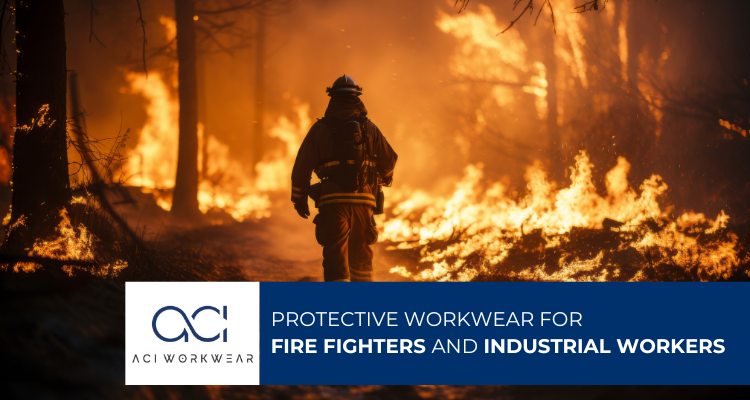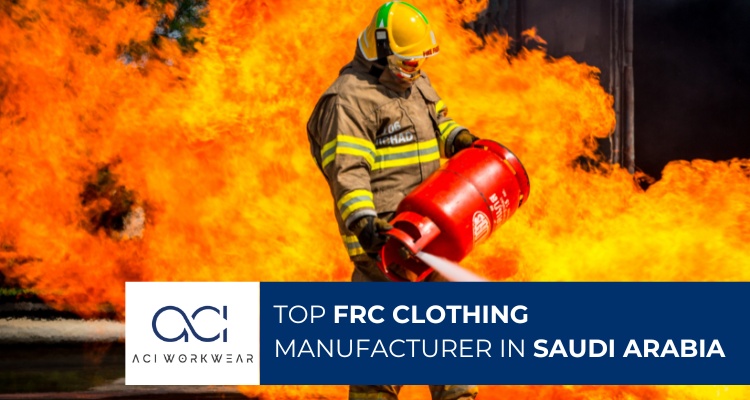
An Ultimate Guide To The Different Materials & Fabrics Used In Safety Workwear
March 21, 2024
Top Safety Workwear Manufacturer in Australia
April 15, 2024If you or your team works in an industry with potential fire and heat hazards, you know how crucial it is to have the right protective gear.
Flame-resistant (FR) clothing is an essential part of keeping yourself safe on the job.
But do you really understand how it works and what to look for when choosing the right gear?
In this post, we’ve explained everything you need to know about Flame Resistant Clothing so that you can select the best option for your crew.
What is Flame-Resistant Clothing?
Flame-resistant clothing is designed to protect from the dangers of fire, heat, and electrical arcs.
Unlike regular clothing, which can easily ignite and fuel a fire, FR clothing is made with special fabrics that are engineered to self-extinguish and resist ignition.
These fabrics provide a barrier between your skin and the heat source, which helps to insulate your body and minimize the risk of serious burns or other thermal injuries.
The key properties of FR fabrics include their ability to:
- Self-extinguish when the heat source is removed
- Resist ignition and prevent the spread of flames
- Provide thermal insulation to protect the wearer
Whether you work in the oil and gas industry, utilities, manufacturing, or any other field with fire and heat hazards, flame-resistant clothing is an essential piece of your personal protective equipment (PPE).
Types of Flame-Resistant Clothing
Now that you understand the purpose of FR clothing, let's take a look at the different types of garments available.
Fire retardant clothing comes in a wide variety of styles and materials, each designed to meet specific needs and hazards.
Some of the most common types of FR clothing include:
- Coveralls — These one-piece garments provide full-body coverage and are often used in industries like oil and gas, manufacturing, and utilities.
- Jackets and pants — Separates allow for more flexibility and customization, allowing you to mix and match different pieces to create the ideal outfit for your work environment.
- Shirts and t-shirts — These lightweight fire retardant clothing options can be worn as base layers or on their own, depending on the level of protection required.
- Undergarments — FR underwear and socks help to provide an additional layer of protection and insulation.
- Specialized items — This includes items like hoods, gloves, and balaclavas that can be used to protect your head, hands, and neck.
The materials used to manufacture fire clothing workwear can vary as well, with common options including natural fibers like cotton and wool, as well as synthetic fabrics like aramids and polyesters.
Each material has its own unique properties and performance characteristics, so it's important to choose the right one for your specific work environment and hazards.
How Does Flame-Resistant Clothing Work?
Now that you know the different types of FR clothing available, let's take a closer look at how they actually protect you from thermal hazards.
Fire retardant clothing is designed to react to heat and flames in a specific way. When exposed to high temperatures or an open flame, the fibers in the fabric begin to break down and form a protective char layer.
This char layer insulates your skin from the heat, slowing the transfer of thermal energy and preventing serious burns.
Additionally, many FR fabrics are engineered to be self-extinguishing. This means that once the heat source is removed, the fabric will stop burning and the fire will be contained. This is a crucial feature that can mean the difference between a minor incident and a life-threatening situation.
The level of thermal protection provided by flame-resistant clothing is measured using two key metrics:
- Thermal protection performance (TPP)
- Arc thermal performance value (ATPV)
These ratings help determine the appropriate level of FR clothing needed for different work environments and the specific hazards present.
How Flame-Resistant Clothing is Rated?
Speaking of ratings, let's dive into the regulatory standards and certification processes that govern the fire retardant clothing industry.
In the United States, the key standards for FR clothing include NFPA 70E, ASTM F1506, and OSHA regulations. These guidelines outline the specific testing methods and performance criteria that fire clothing workwear must meet to be considered safe and effective.
The testing process typically involves exposing fabric samples to various heat and electrical arc sources to measure their ability to self-extinguish, resist ignition, and provide thermal insulation.
The results of these tests are then used to determine the TPP and ATPV ratings for the garment.
These ratings are crucial when it comes to selecting the appropriate flame-resistant clothing for your work environment.
The higher the TPP and ATPV values, the more protection the garment will provide against thermal hazards. So, it's important to choose FR clothing that matches the specific risks and hazards present in your workplace.
Limitations of Flame-Resistant Clothing
While fire retardant clothing is an essential piece of safety equipment, it's important to understand that it does have its limitations.
No matter how well-designed and tested the garment may be, it cannot completely eliminate the risk of injury in the event of an extreme fire or explosion.
Flame-resistant clothing is primarily designed to provide protection against radiant heat, convective heat, and electrical arcs. It may not offer the same level of protection against other types of thermal hazards, such as molten metal splashes or direct flame impingement.
Additionally, FR clothing can sometimes be less breathable and comfortable compared to regular workwear, which can be a concern in hot or physically demanding work environments.
So, it’s important to remember that flame-resistant clothing is just one part of a comprehensive safety program.
That’s why, it should be used in conjunction with other protective equipment, proper training, and a thorough hazard assessment to ensure the safety of workers in high-risk environments.
Conclusion
As you can see, flame-resistant clothing is a critical component of safety for anyone working in industries with fire and heat hazards.
Remember, when it comes to fire retardant clothing, it's not just about checking a box – it's about keeping yourself and your colleagues safe from the very real dangers of thermal injuries.
When it comes to sourcing high-quality fire retardant clothing, one name stands out above the rest — ACI Workwear.
As the leading fire clothing workwear manufacturer in India, ACI Workwear has been providing top-of-the-line FR clothing solutions for industries across the country. From fire-resistant coveralls to specialized FR accessories, ACI has everything you need to create a comprehensive safety solution for your workplace.









